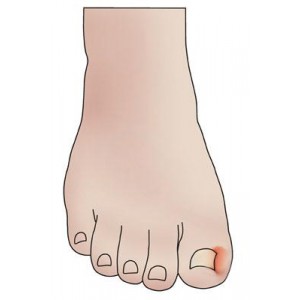Ingrown Toenail
Ingrown Toenail:
An ingrown toenail is a painful condition characterized by the nail digging into the surrounding skin, leading to inflammation and possible infection of the toe. This is a serious condition for people with impaired circulation, diabetes, or other systemic diseases.
Symptoms:The most common symptom of an ingrown toenail is pain, especially if the area becomes infected. The surrounding skin might be deep pink and release a discharge or pus, or it might appear raw with a red, moist lump overlapping the nail edge.
Causes:
Prevention:
Treatment:In the early stages of an ingrown toenail, soak your foot in warm water containing antimicrobial soap or a few tablespoons of salt. Dry your foot and apply an over-the-counter antibiotic ointment and a clean dressing. Do not cut your nail. For the next few days, wear open-toed or loose-fitting shoes. When the nail grows out, cut it straight across. More advanced ingrown toenails require the attention of a healthcare professional, such as a podiatrist.
Warning: We hope these suggestions improve your health and make you more comfortable. However, if you have any concerns about our advice, if any symptom persists for an unreasonable amount of time or if your condition worsens after self-treatment, we encourage you to consult a medical professional for further assistance.Please note, people with diabetes and poor circulation should always consult a medical professional before performing any self-treatment.
An ingrown toenail is a painful condition characterized by the nail digging into the surrounding skin, leading to inflammation and possible infection of the toe. This is a serious condition for people with impaired circulation, diabetes, or other systemic diseases.
Symptoms:The most common symptom of an ingrown toenail is pain, especially if the area becomes infected. The surrounding skin might be deep pink and release a discharge or pus, or it might appear raw with a red, moist lump overlapping the nail edge.
Causes:
- Heredity
- Improper nail trimming
- Trauma
- Shoe pressure
- Poor foot structure
Prevention:
- Trim toenails straight across as a preventative measure
- Select the proper shoe style and size.
Treatment:In the early stages of an ingrown toenail, soak your foot in warm water containing antimicrobial soap or a few tablespoons of salt. Dry your foot and apply an over-the-counter antibiotic ointment and a clean dressing. Do not cut your nail. For the next few days, wear open-toed or loose-fitting shoes. When the nail grows out, cut it straight across. More advanced ingrown toenails require the attention of a healthcare professional, such as a podiatrist.
Warning: We hope these suggestions improve your health and make you more comfortable. However, if you have any concerns about our advice, if any symptom persists for an unreasonable amount of time or if your condition worsens after self-treatment, we encourage you to consult a medical professional for further assistance.Please note, people with diabetes and poor circulation should always consult a medical professional before performing any self-treatment.



